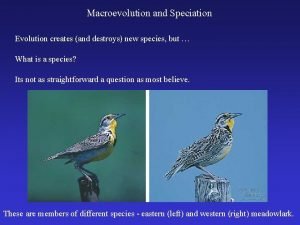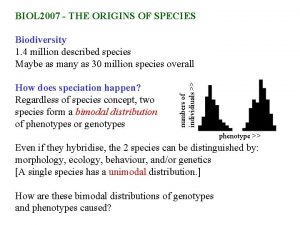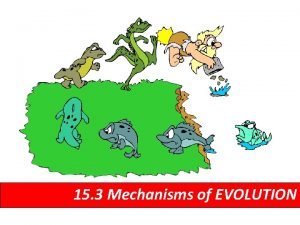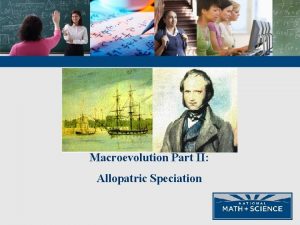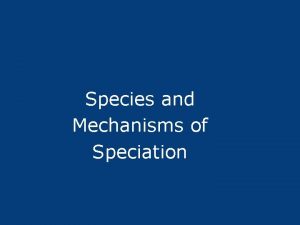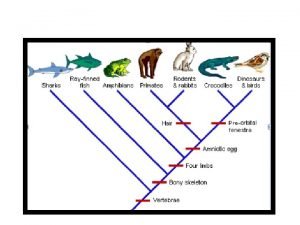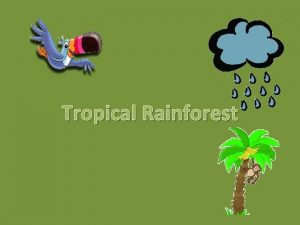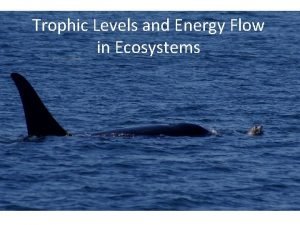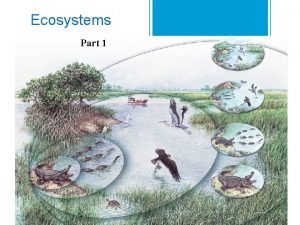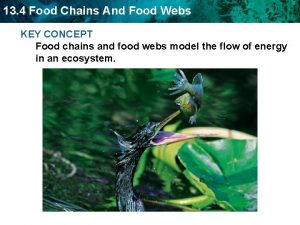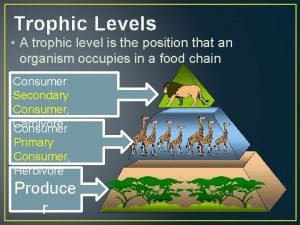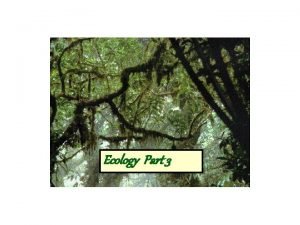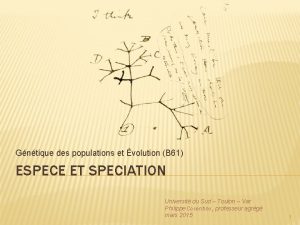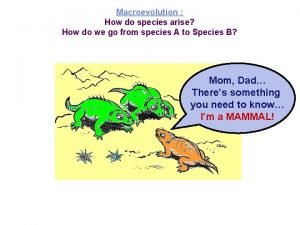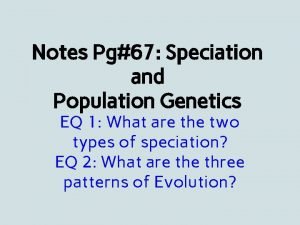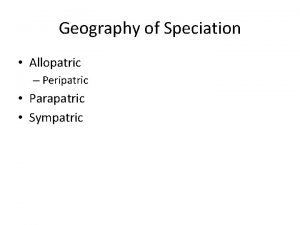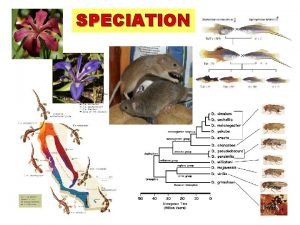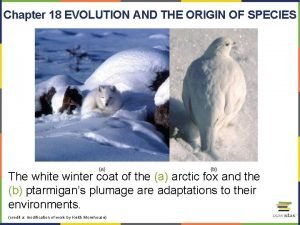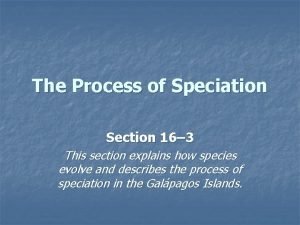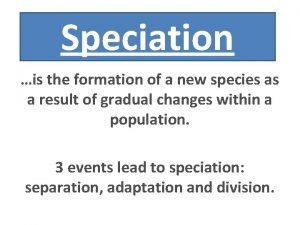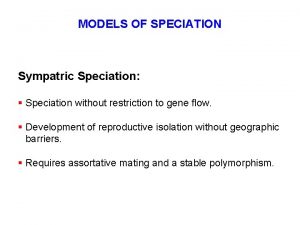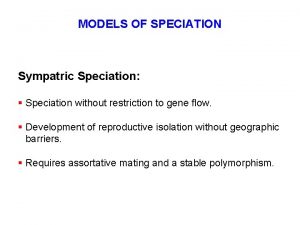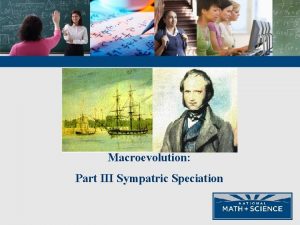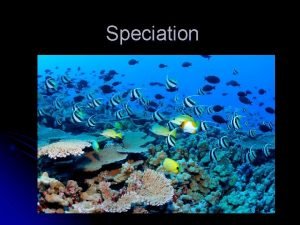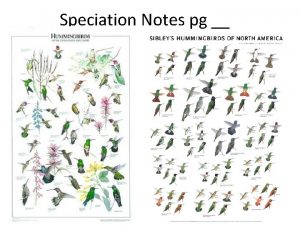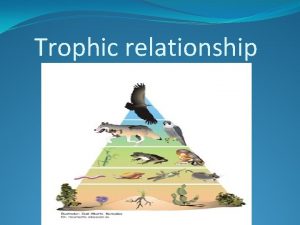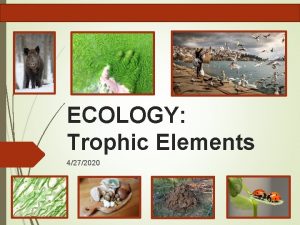Discussion of Sequential Sympatric Speciation Across Trophic Levels


































- Slides: 34

Discussion of Sequential Sympatric Speciation Across Trophic Levels by Andrew A. Forbes, Thomas H. Q. Powell, Lukasz L. Stelinski, James J. Smith and Jeffrey L. Feder Department of Biological Sciences, University of Notre Dame Department of Entomology and Nematology, University of Florida Department of Entomology, Michigan State University Science 323: 776 -779 February 6, 2009 BIO 101, Nov. 18, 2011

What’s the overall question? What’s the overall conclusion?

What’s the overall question? Does biodiversity lead to more biodiversity? New species should give rise to new niches for other organisms. What’s the overall conclusion?

What’s the overall question? Does biodiversity lead to more biodiversity? New species should give rise to new niches for other organisms. What’s the overall conclusion? Evidence demonstrates that the wasp Diachasma alloeum has sympatrically speciated into two new species, preying on different groups of flies (which feed on different trees).

The Cast of Characters: Plants: Hawthorne – small trees native to North America and Europe Apple Trees – small trees introduced to North America from Europe around 1625 same Family as Hawthorn Snowberry and Blueberry smaller shrubs

The Cast of Characters: The Flies: Rhagoletis pomonella “apple maggot” larvae damages tree fruit two distinct groups living on Hawthorne or Apple Trees R. mendax living on blueberry R. zephyria living on snowberry

The Cast of Characters: The Wasp: Diachasma alloeum parasitoid on all of these Rhagoletis species larvae

The Cast of Characters: Three trophic levels: Wasp Fly Plant

Evolutionary Changes Two “races” of R. pomonella have emerged one (ancestral) is adapted to live on hawthorn trees one (recent) is adapted to live on apple trees

Evolutionary Changes Two “races” of R. pomonella have emerged one (ancestral) is adapted to live on hawthorn trees one (recent) is adapted to live on apple trees Hypothesis: Different groups of wasps may have specialized to each of these groups of flies.

Evolutionary Changes Two “races” of R. pomonella have emerged one (ancestral) is adapted to live on hawthorn trees one (recent) is adapted to live on apple trees Hypothesis: Different groups of wasps may have specialized to each of these groups of flies. Are there detectable genetic differences among these groups of wasps?

Genetic Analyses of Wasps Collect wasps Several locations Several hosts

Genetic Analyses of Wasps Determine sequences of a mitochondrial gene and compare vs. host plants. Three distinct sequences (haplotypes) detected.

Genetic Analyses of Wasps Determine sequences of a 21 microsatellites. 9 were useful as they showed host-related correlations. red = hawthorn green = apple blue = blueberry black = snowberry

Genetic Analyses of Wasps Alleles 196, 200 and 204 at microsatellite DA 003 were exceptionally helpful. 196 was common in apple wasps (29%), blueberry wasps (18%) and snowberry wasps (26%) but absent in 385 hawthorn wasps.

Genetic Analyses of Wasps Alleles 196, 200 and 204 at microsatellite DA 003 were exceptionally helpful. 196 was common in apple wasps (29%), blueberry wasps (18%) and snowberry wasps (26%) but absent in 385 hawthorn wasps. What’s more important: location or host plant?

Genetic Analyses of Wasps Are the genetic changes consistent with a new wasp species, specializing on appledwelling flies?

Behavioral Analyses of Wasps How do the wasps know what trees to go to? Flies use volatile compounds from fruits to find the right plants. Do wasps? Proc. Natl. Acad. Sci. USA 100: 11490

Behavioral Analyses of Wasps Y-Tube Olfactometer Fruit odor in one flask. Second flask was empty. Add wasp at red arrow. Record wasp movement.

Behavioral Analyses of Wasps Positive values indicate that the wasp was moving towards the scent. Negative values indicate that the wasp was moving away. ** P<0. 01, *** P <0. 001, others not statistically significant Conclusion?

Behavioral Analyses of Wasps Positive values indicate that the wasp was moving towards the scent. Negative values indicate that the wasp was moving away. ** P<0. 01, *** P <0. 001, others not statistically significant Is this a prezygotic barrier to gene flow?

Life Histories Typical life cycle of insects: These flies lay eggs in fruit. Larvae emerges and eats fruit. Fruit falls from the tree. Larvae leaves the fruit and overwinters as pupae in soil (diapause). Adult emerges from pupae (eclosion) in next summer. Only one generation per year. Adult lives only about 28 days.

Life Histories Typical life cycle of insects: These wasps lay eggs in fly larva. Eggs hatch and wasp larvae eats fly pupae. Wasp spends winter as pupae. Emerges in summer (eclosion). Also one generation per year. Adults live for an average of 13 days.

Life Histories Does eclosion timing differ with different groups of wasps? Field-collected wasps were allowed to lay eggs in matching flies. Chilled to 4 o. C for 4 months (to simulate winter). Warmed to 21 o. C and daily monitored for eclosion.

Life Histories Does eclosion timing differ with different groups of wasps?

Life Histories Does eclosion timing differ with different groups of flies and wasps?

Life Histories If adults live an average of 13 days, is this causing a barrier to gene flow?

Life Histories Variation in eclosion timing may be partially explained by genotype at locus DA 003

Model: Hawthorn

Model: ~300 years ago Apple Hawthorn

Model: ~150 years ago ~300 years ago Apple Hawthorn

Model: Currently seeing sympatric speciation of wasps ~150 years ago ~300 years ago Apple Hawthorn

Model: Currently seeing sympatric speciation of wasps. Major evidence: • Genetic differences in wasp populations. • Behavioral differences that could lead to a prezygotic barrier to gene flow. • Life history differences that could be a prezygotic barrier to gene flow.

Model: Currently seeing sympatric speciation of wasps. Major evidence: • Genetic differences in wasp populations. • Behavioral differences that could lead to a prezygotic barrier to gene flow. • Life history differences that could be a prezygotic barrier to gene flow. So is D. alloeum one species? Or do we break it into two (D. alloeum-apple and D. alloeum-hawthorn)?
 Sympatric speciation vs allopatric speciation
Sympatric speciation vs allopatric speciation Sympatric speciation
Sympatric speciation Allopatric speciation example
Allopatric speciation example Sympatric speciation
Sympatric speciation Parapatric speciation
Parapatric speciation Hybrid inviability definition
Hybrid inviability definition Natural hybridization and evolution
Natural hybridization and evolution Allopatric speciation def
Allopatric speciation def Swan food web
Swan food web Tropical rainforest symbiotic relationships
Tropical rainforest symbiotic relationships How does energy flow in an ecosystem
How does energy flow in an ecosystem Secondary consumers
Secondary consumers Carp food web
Carp food web Energy flow trophic levels
Energy flow trophic levels Trophic level energy transfer
Trophic level energy transfer Nutrient chain foldable
Nutrient chain foldable What are the 4 trophic levels
What are the 4 trophic levels What are the part of ecosystem
What are the part of ecosystem 5 level food chain
5 level food chain Trophic level
Trophic level Ecological pyramid of energy
Ecological pyramid of energy Ecological pyramid of biomass
Ecological pyramid of biomass A community may move
A community may move Different food chain
Different food chain Teaching across age levels
Teaching across age levels Fractional distillation conclusion
Fractional distillation conclusion Costa's levels of questioning
Costa's levels of questioning Scala naturae
Scala naturae Connecting the concepts: macroevolution
Connecting the concepts: macroevolution Speciation
Speciation Parapatric speciation
Parapatric speciation Ring species
Ring species Origin of species manga 18
Origin of species manga 18 Section 16-3 the process of speciation
Section 16-3 the process of speciation Speciation or the formation of new species is
Speciation or the formation of new species is
